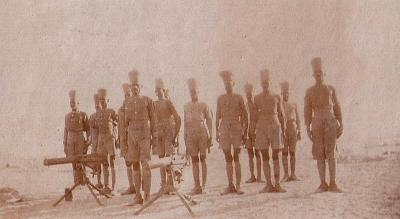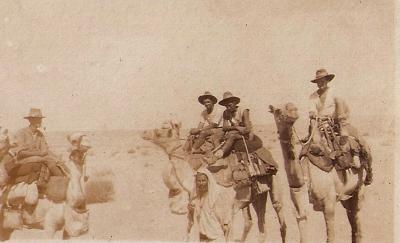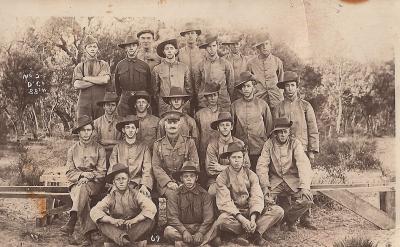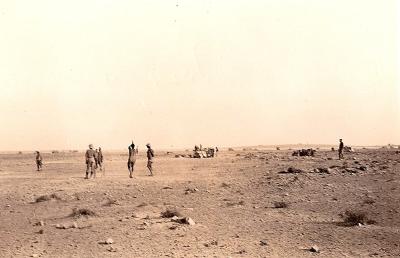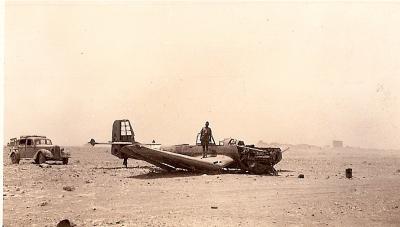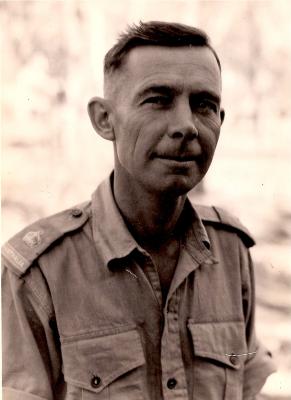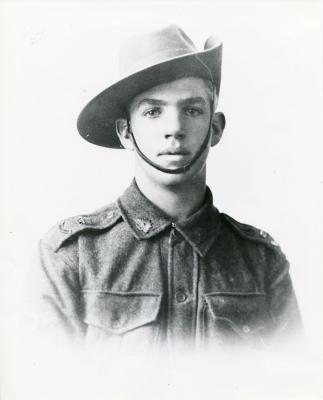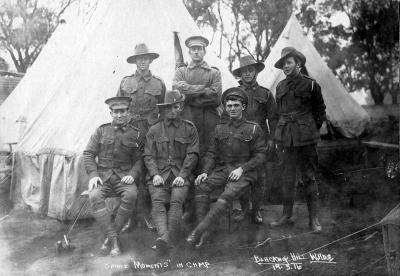World War 1, Middle East, Syria, Maghaba, Hong Kong Battery, 1918
1918Hong Kong Battery going into action Maghaba. After war had commenced in 1914 the commander of Hong Kong Mountain Battery requested an overseas operational deployment for his sub-unit. This was granted in September 1915 when the War Office requested a four 10-pounder gun battery be deployed to Egypt; the number of guns required was then increased to six. No 1 Company was the nucleus of this new battery but drafts were allotted from No 4 Company in Mauritius and No 5 Company in Singapore; there was keen competition throughout the battalion to be selected for this deployment. The battery strength was: 3 British officers, 3 Indian officers, 205 Rank and File and a few British non-commissioned-officer (NCO) specialists. Initially mules were the pack animals. The battery embarked at Hong Kong on 8 November 1915, called in at Singapore to collect the draft from that station, and disembarked at Suez; the draft from Mauritius joined in Moascar near Ismailia where the battery was attached to the Imperial Service Cavalry Brigade.
The Battle of Magdhaba took place on 23 December 1916 during the Defence of Egypt section of the Sinai and Palestine Campaign in the First World War. The attack by the Anzac Mounted Division took place against an entrenched Ottoman Army garrison to the south and east of Bir Lahfan in the Sinai desert, some 29 –40 km inland from the Mediterranean coast. This Egyptian Expeditionary Force (EEF) victory against the Ottoman Empire garrison also secured the town of El Arish after the Ottoman garrison withdrew.
Details
Details
The 10 pounder mountain gun weapon system is fitted with two part rifled barrel that screwed together for use in mountainous regions. It was designed to be carried by pack animals. It could be dismantled into 4 loads of approximately 90.7 kg for mule transport. The carriage was a conventional box type iron trail. The gun fired a 4.7 kg projectile up to 5,480 metres at 393 m/s. The ammunition used included solid, shrapnel or case shot. The total weight of the weapon complete was 396 kg. The calibre of the weapon is 2.75 inch/70mm (10 pounds) with a barrel length of 28 calibres.
The 10 pounder Screw Breech Mountain Gun was introduced into British Indian Army service in 1903 and it went on to serve during World War 1 during campaigns in Africa, the Middle East as well as the in Dardanelles.
On 25 April 1915 a 10 Pounder Mountain gun of the 7th Indian Mountain Artillery Brigade (21st Kohat battery, 26th Jacob’s Battery) was used to support the Australian and New Zealand troops on the Gallipoli Peninsula. The guns of this brigade went on to become a well-known and liked support element to the combined Australian, New Zealand, Indian and UK forces serving on the Gallipoli beachhead in 1915.
Australian Army Museum of Western Australia
Australian Army Museum of Western Australia
Other items from Australian Army Museum of Western Australia
- World War 1, Egypt, Serapeum, 1918
- World War 1, Europe Turkiye, Gallipoli, Indian Machine Gun Section, 1915
- World War 1, South West Asia, Syria, 10 Australian Light Horse, 1918
- Pre 1914, Australia, Western Australia, 88 Battalion. 1912
- World War 1, Australia Western Australia, PEMBERTON, AFA, 1916
- World War 2, North Africa, Libya, Tobruk, 2/28 Battalion, 1941
- World War 2, North Africa, Libya, Tobruk, 2/28 Battalion, 1941
- World War 2, Middle East, ARMSTRONG, 2/28 Battalion, 1942
- Post 1945 , Australia, Western Australia, Albany, Desert Mounted Corps Memorial, 1960
- World War 1, Australia Western Australia, 2149 COOPER, 1915
- World War 1, Europe, COOPER, 1916
- World War 1, Australia Western Australia Blackboy Hill Camp, KENNEDY, 1916

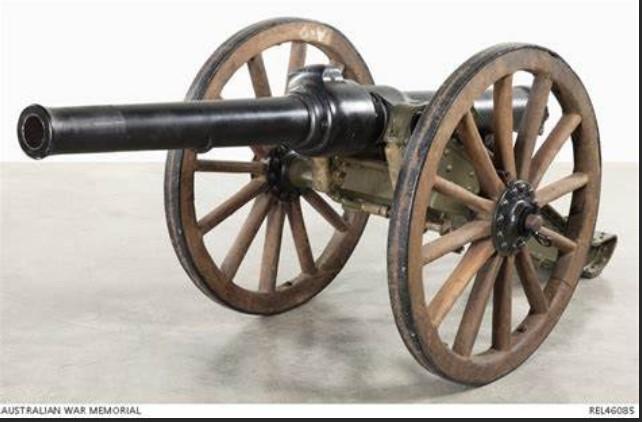
Scan this QR code to open this page on your phone ->


